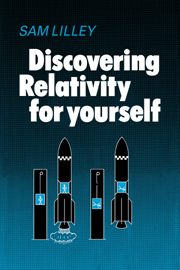Book contents
- Frontmatter
- Contents
- Preface
- Introduction
- 1 Getting started
- 2 Rough and ready Relativity
- 3 The dilation of time
- 4 Three clocks and a pair of twins
- 5 Starting again
- 6 Space–time diagrams
- 7 Time and distance ‘over there’
- 8 Co-ordinate systems
- 9 Combining speeds
- 10 Causality and the speed of light
- 11 The nature of spacetime
- 12 Interval
- 13 Old friends revisited
- 14 The scales of the spacetime diagram
- 15 The radar point of view
- 16 Relations between the radar and time–distance systems
- 17 Constant acceleration
- 18 Dynamics–mass, momentum, force
- 19 The mass–energy relation
- 20 The effect of acceleration on time measurement
- 21 Time as experienced by a constant acceleration traveller
- 22 Time and distance measurements of a constant acceleration observer
- 23 The Principle of Equivalence
- 24 The metric
- 25 Introducing geodesies
- 26 How to find ordinary geodesies
- 27 Inverse square law gravity
- 28 Curved spacetime
- 29 The metric around the Sun
- 30 Light and gravity
- 31 The scandal about Mercury
- 32 How Einstein did it
- 33 A few conclusions
- Index
27 - Inverse square law gravity
Published online by Cambridge University Press: 15 March 2010
- Frontmatter
- Contents
- Preface
- Introduction
- 1 Getting started
- 2 Rough and ready Relativity
- 3 The dilation of time
- 4 Three clocks and a pair of twins
- 5 Starting again
- 6 Space–time diagrams
- 7 Time and distance ‘over there’
- 8 Co-ordinate systems
- 9 Combining speeds
- 10 Causality and the speed of light
- 11 The nature of spacetime
- 12 Interval
- 13 Old friends revisited
- 14 The scales of the spacetime diagram
- 15 The radar point of view
- 16 Relations between the radar and time–distance systems
- 17 Constant acceleration
- 18 Dynamics–mass, momentum, force
- 19 The mass–energy relation
- 20 The effect of acceleration on time measurement
- 21 Time as experienced by a constant acceleration traveller
- 22 Time and distance measurements of a constant acceleration observer
- 23 The Principle of Equivalence
- 24 The metric
- 25 Introducing geodesies
- 26 How to find ordinary geodesies
- 27 Inverse square law gravity
- 28 Curved spacetime
- 29 The metric around the Sun
- 30 Light and gravity
- 31 The scandal about Mercury
- 32 How Einstein did it
- 33 A few conclusions
- Index
Summary
Constant gravity exists only as an approximation that does well enough in small regions of space. And on this small scale the only case where Einstein's theory gives a detectably different prediction from Newton's is that of §§23.14–16. For further tests we have to consider vast spaces in which gravity obviously varies from place to place. And to cope with these more complex conditions we shall have to modify two of our most basic assumptions.
Our most fundamental assumption of all–Einstein's Principle of Relativity (§5.11)–involves the explicit condition ‘In the absence of gravity …’. In constant gravity conditions would it still be true that all inertial observers are equivalent?
Yes–since the inertial observers in this case are exactly like those of the no-gravity case, but observed by an accelerated observer (§§23.6, 23.12).
If, on the other hand, gravity varies from place to place, then this Principle is no longer true. For simplicity imagine that the Earth is the only massive body in the Universe. Then (ii) and (iv) of §23.5 are inertial observers, one at the Earth's surface, the other very very far away in space. Our demonstration (§23.6) that these have identical experiences only worked because we confined our observers to small rooms. If we let them watch things moving inertially a few thousand miles away, will their experiences be the same?
No. As (ii) sees it, such things will have accelerations of different sizes in different directions (depending on position relative to the Earth's centre). But (iv) will detect no deviation from motion in a straight line at constant speed.
- Type
- Chapter
- Information
- Discovering Relativity for Yourself , pp. 320 - 337Publisher: Cambridge University PressPrint publication year: 1981
- 1
- Cited by



